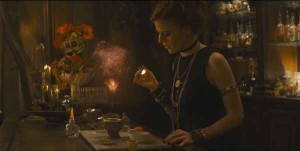
The company was brought on at the 11th hour, tasked with enhancing and augmenting 148 shots that were not originally intended to contain CG elements. This included extending practical sets and enhancing plate photography with magical, fiery embers.
This included a full CG set extension without the use of greenscreen. “The production realized that what they had shot on the day for the chamber just wasn’t grand enough,” explained Mat Krentz, visual effects supervisor. “They wanted something bigger and more impressive.”
“We opened the room up more, and added a CG set extension consisting of columns, alcoves and sentinel-like monster statues. That meant a great deal of roto work, given there was no greenscreen on the set.”
Other shots included the addition of magical elements, such as glowing, floating chandeliers. Given the unintended nature of these CG elements, their inclusion required a high degree of technical skill.
“Production didn’t capture the HDRIs or lighting information on set as their intention was to just use the plate photography,” said Krentz. “We solved this challenge by reconstructing a 3D set lighting environment, integrating our CG work using information from the plate alone.”




